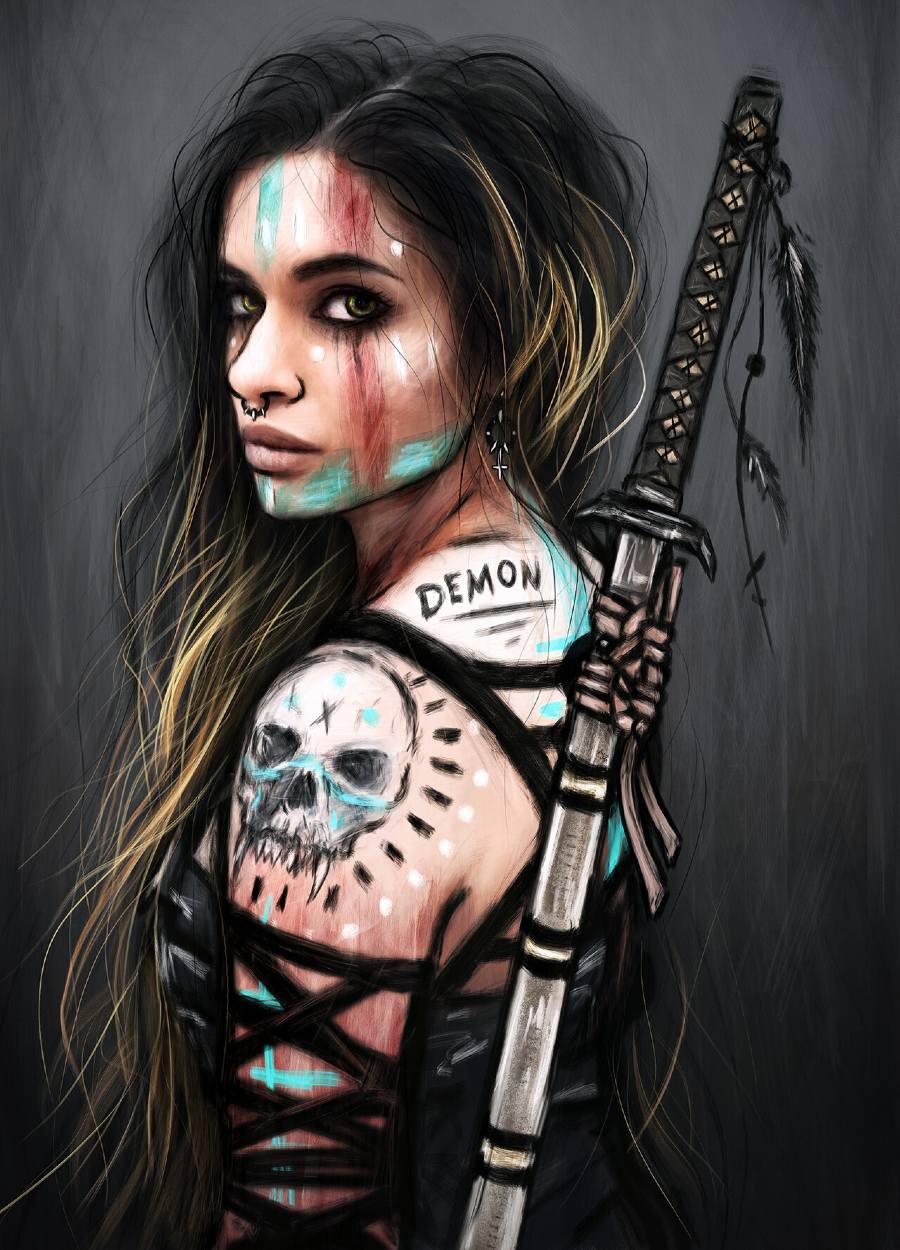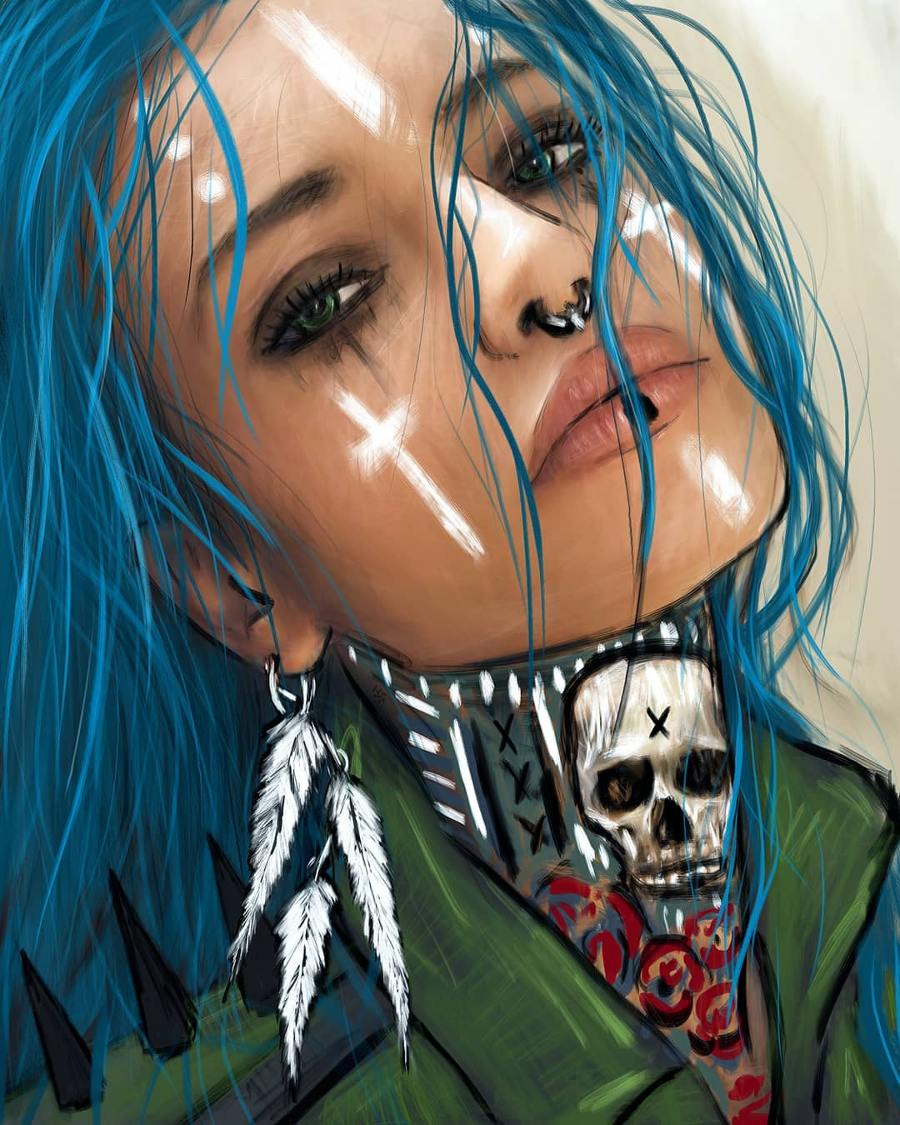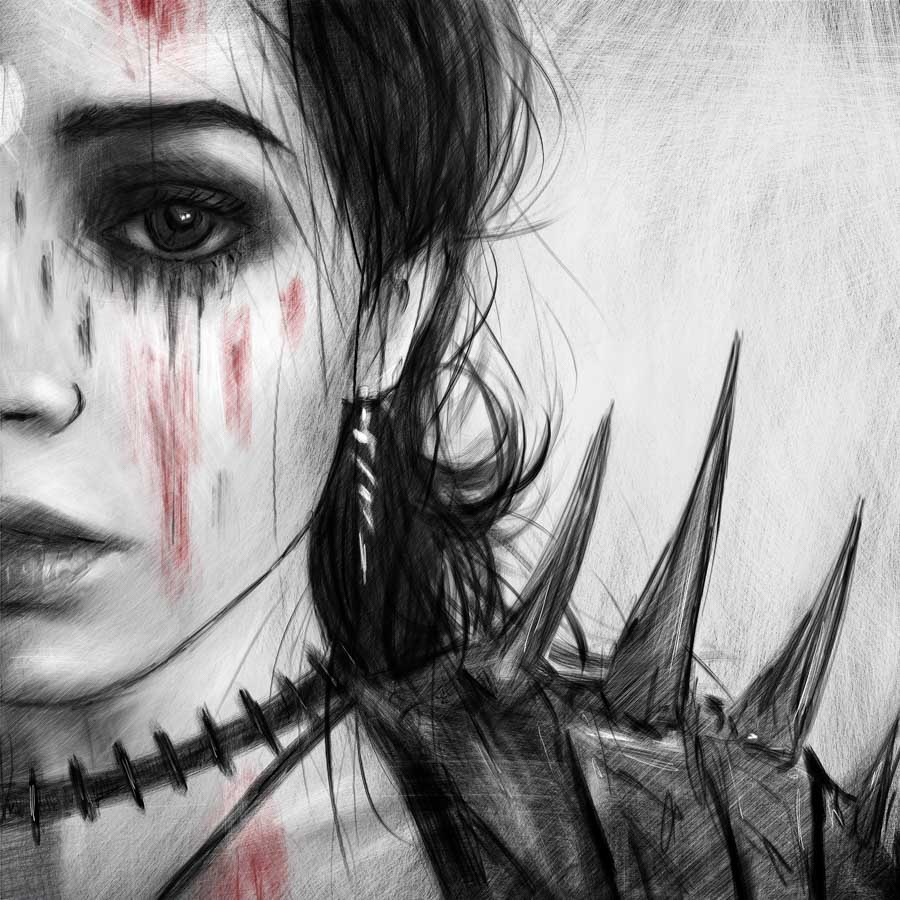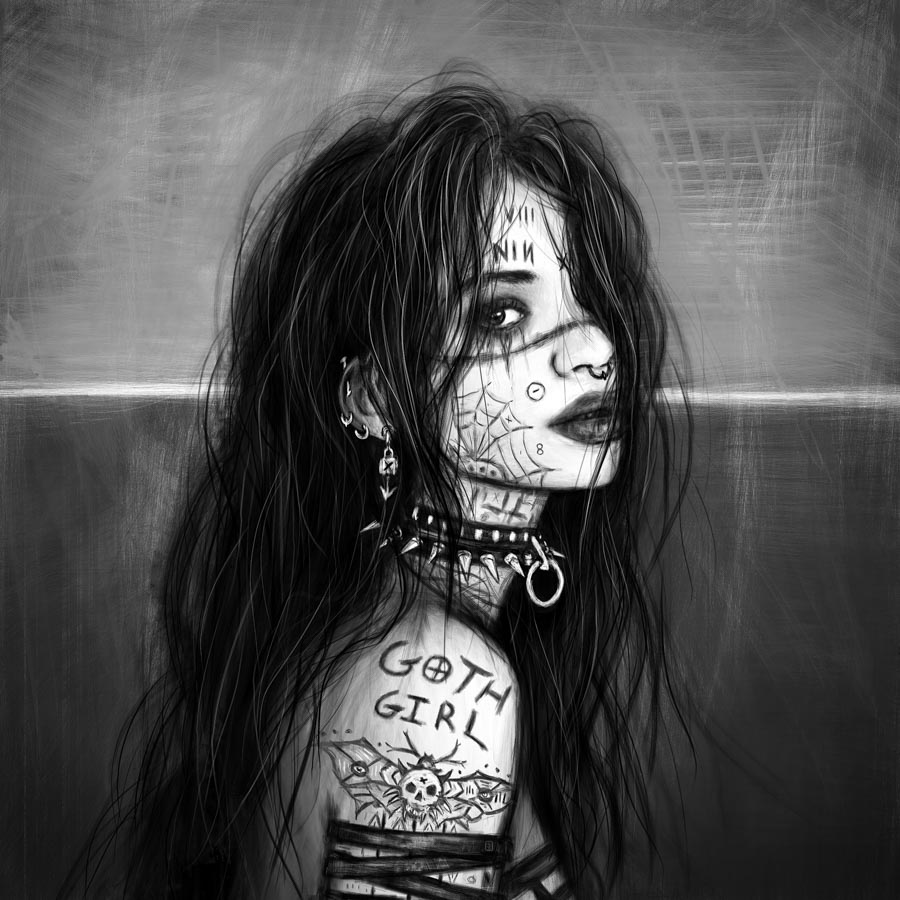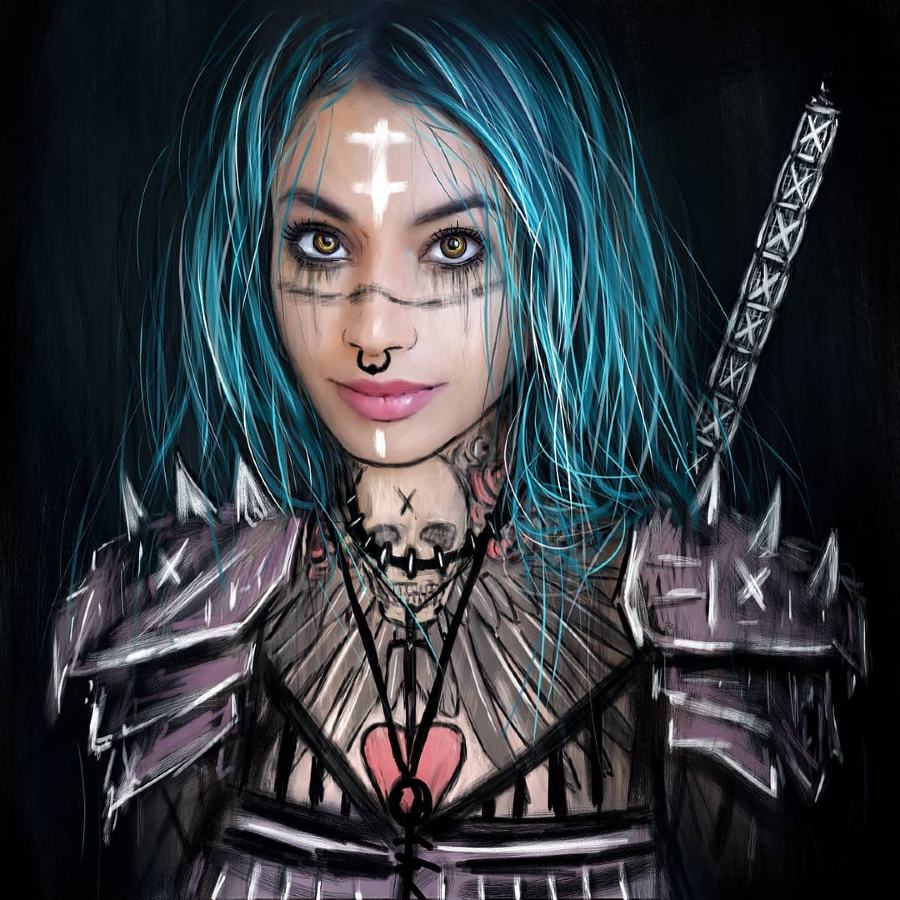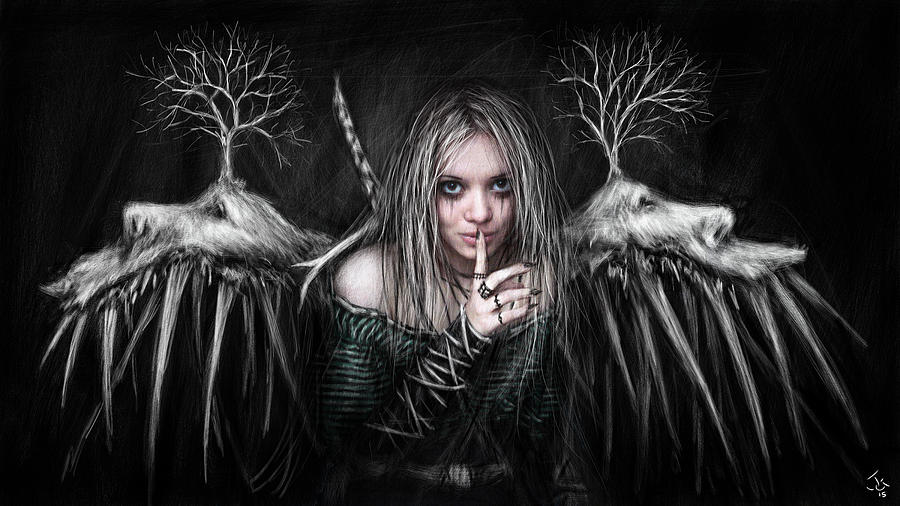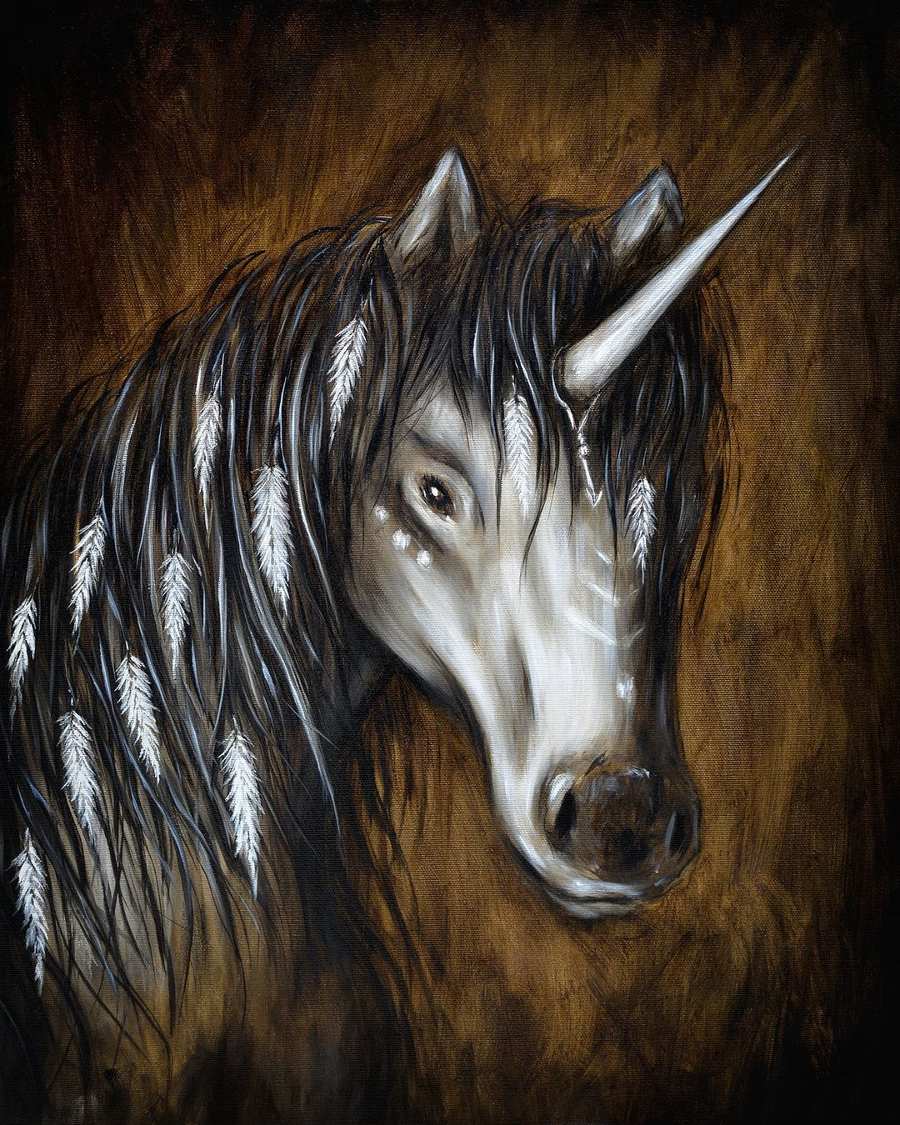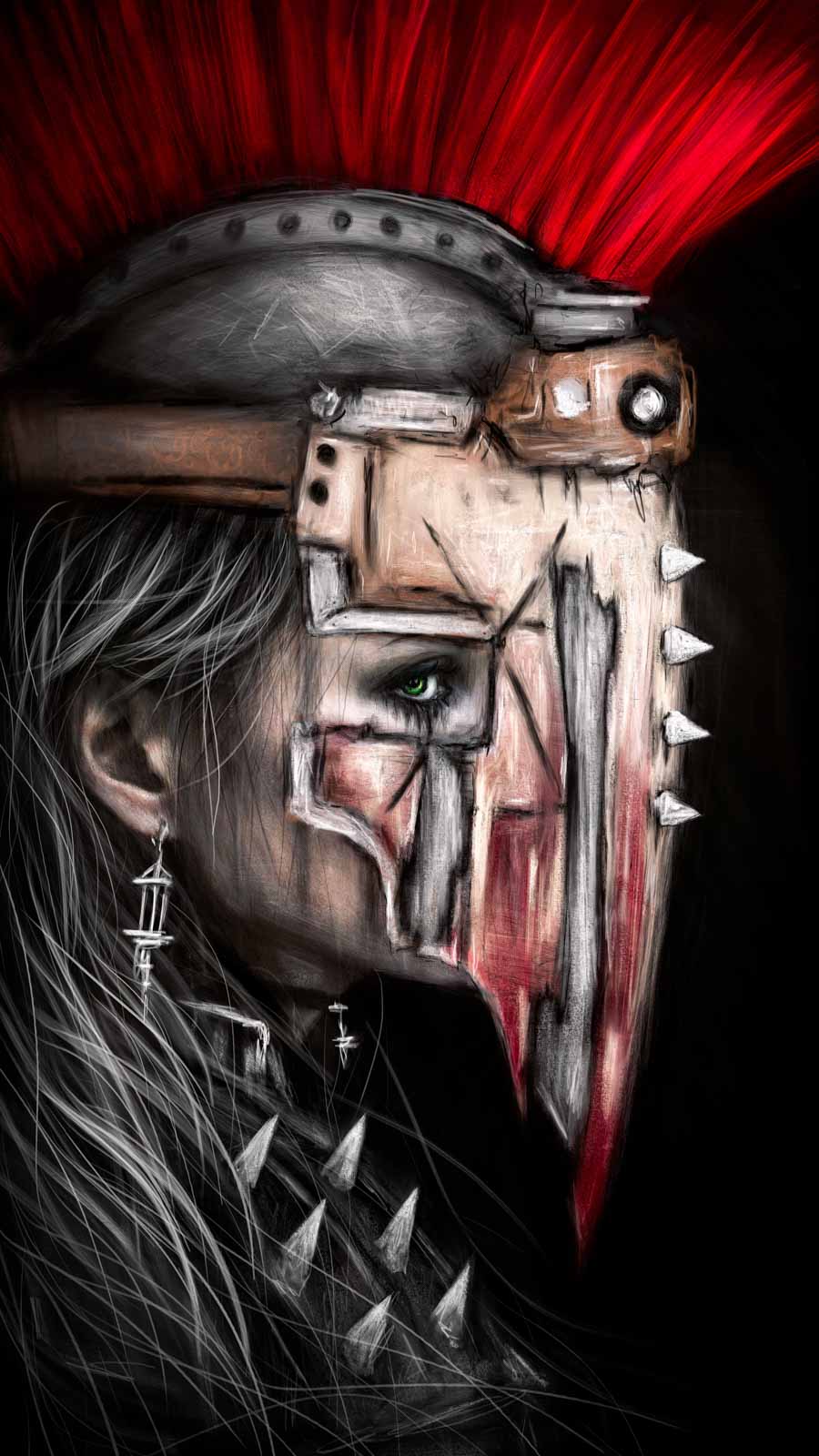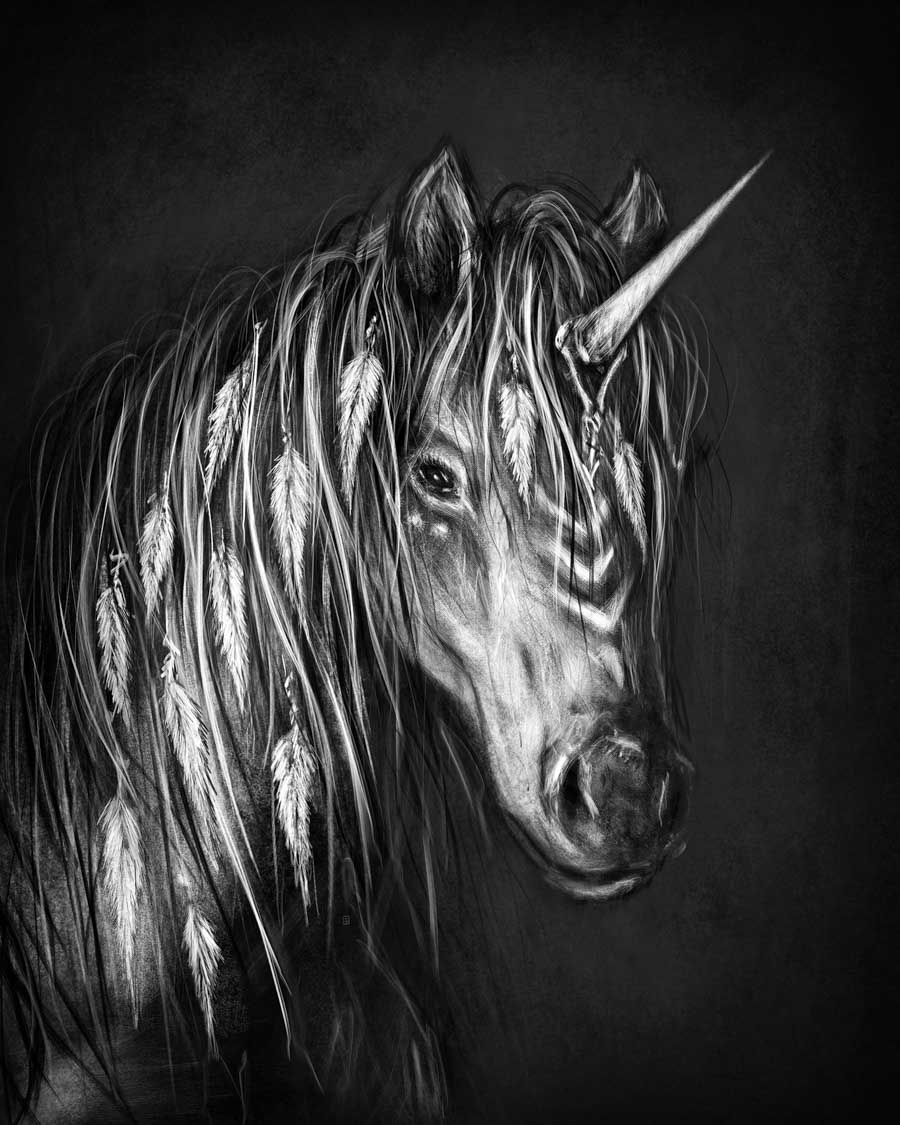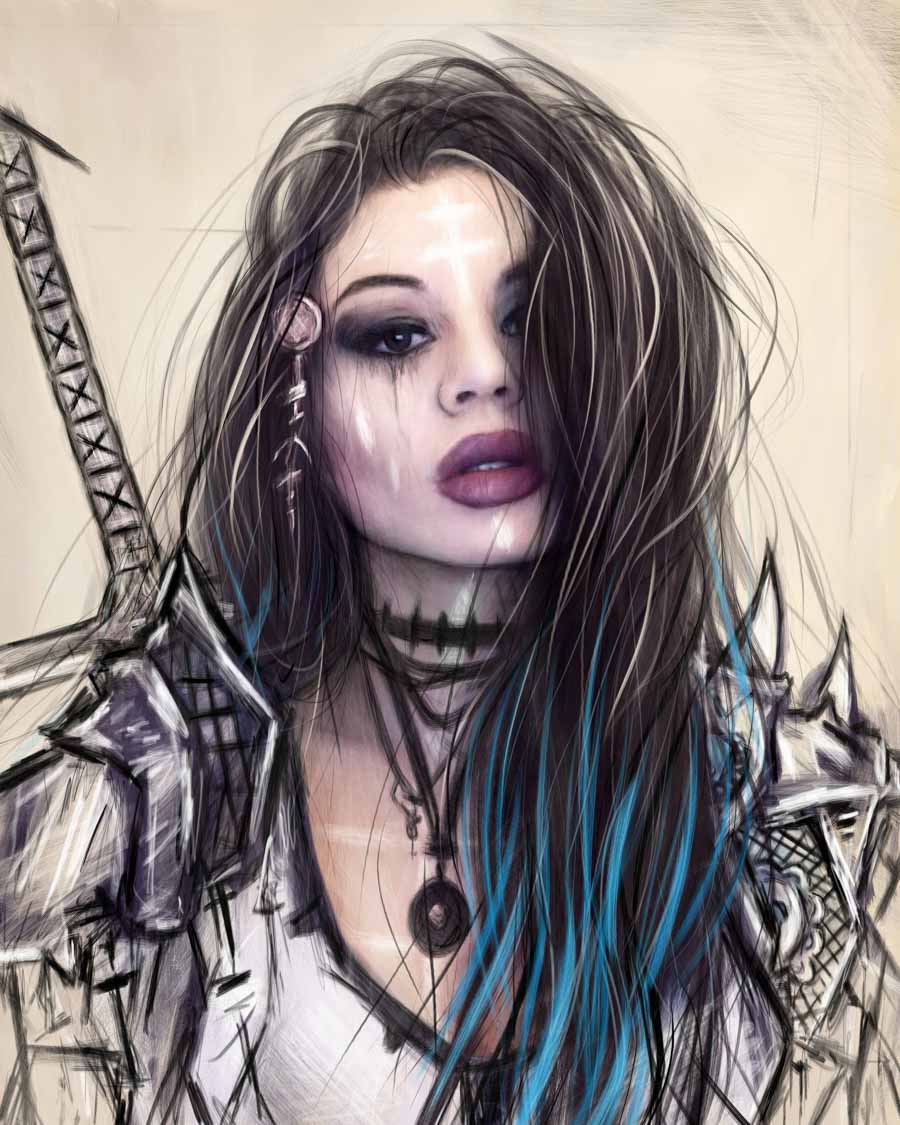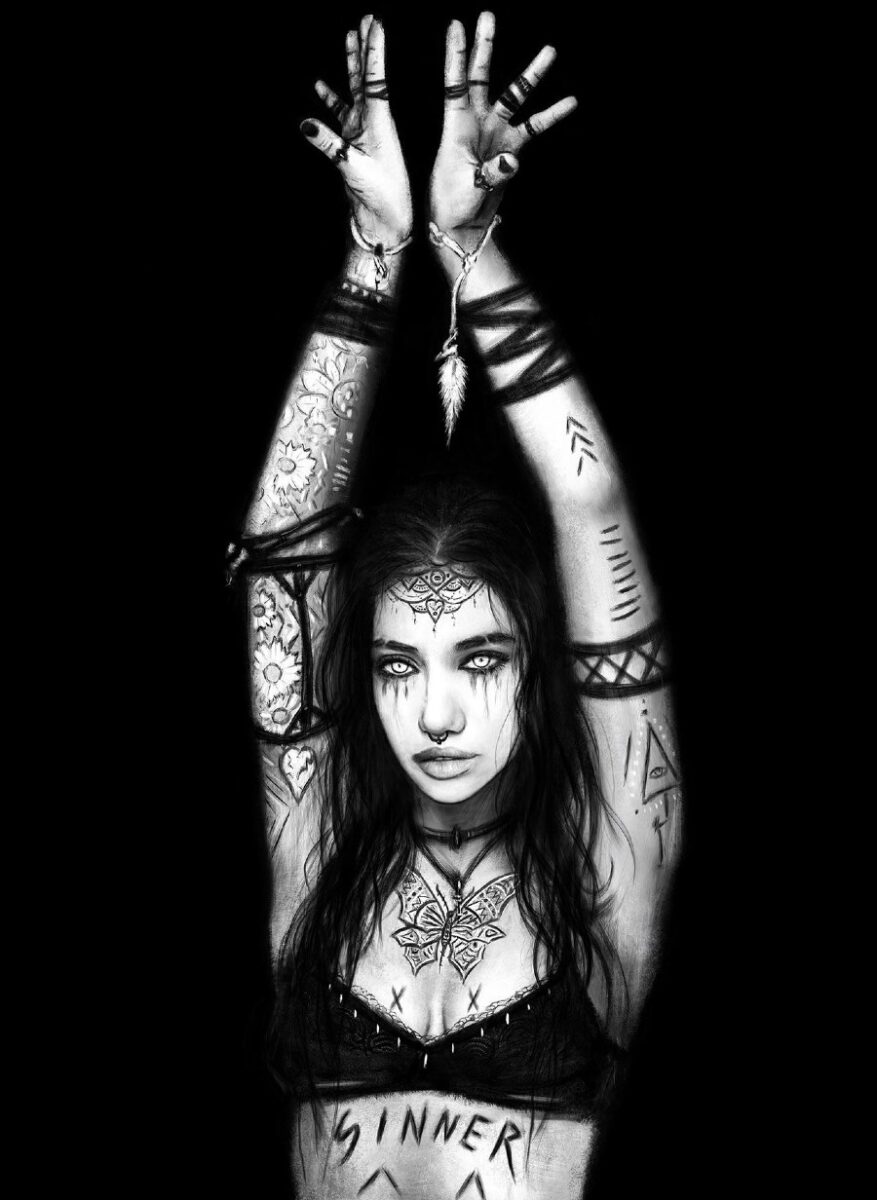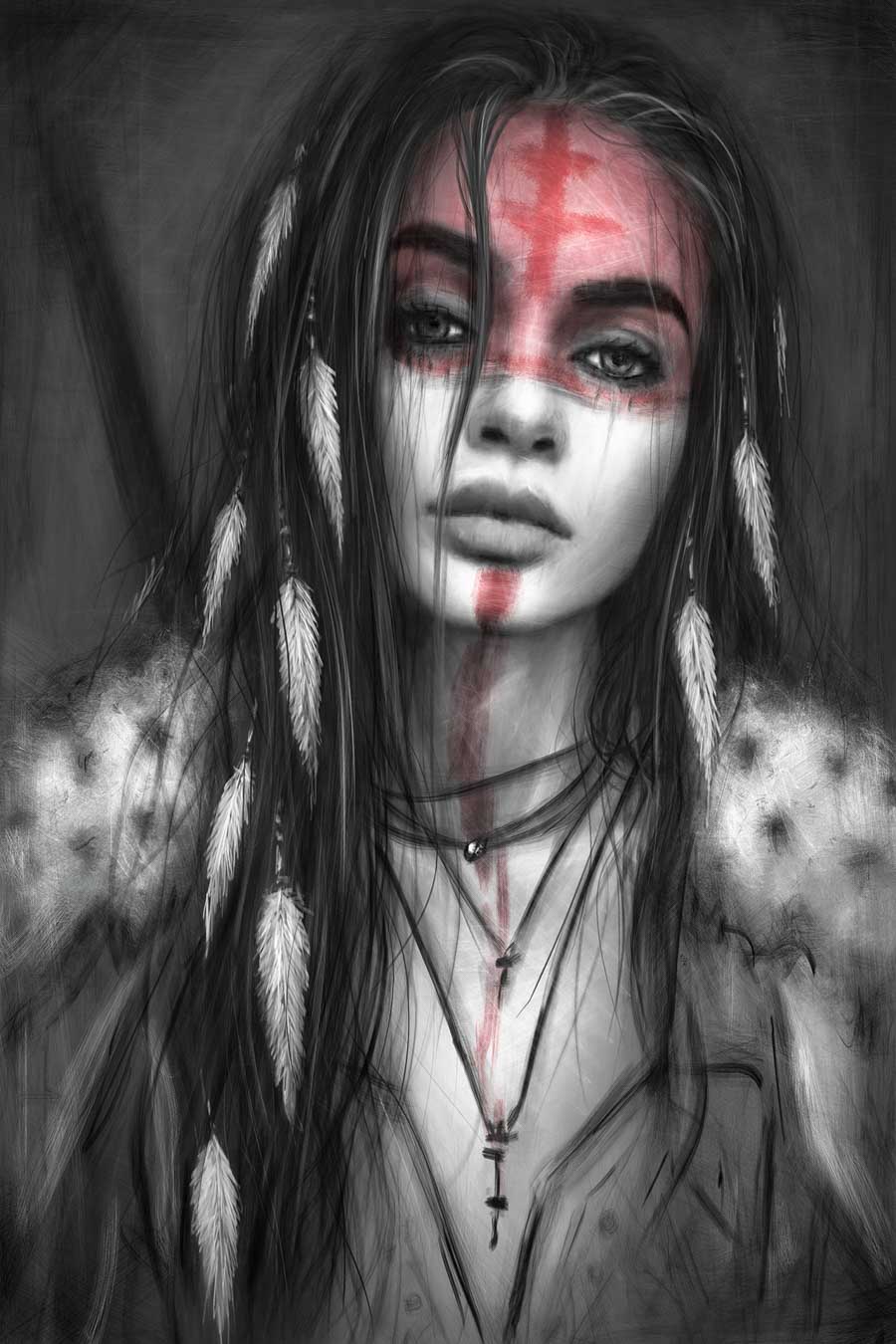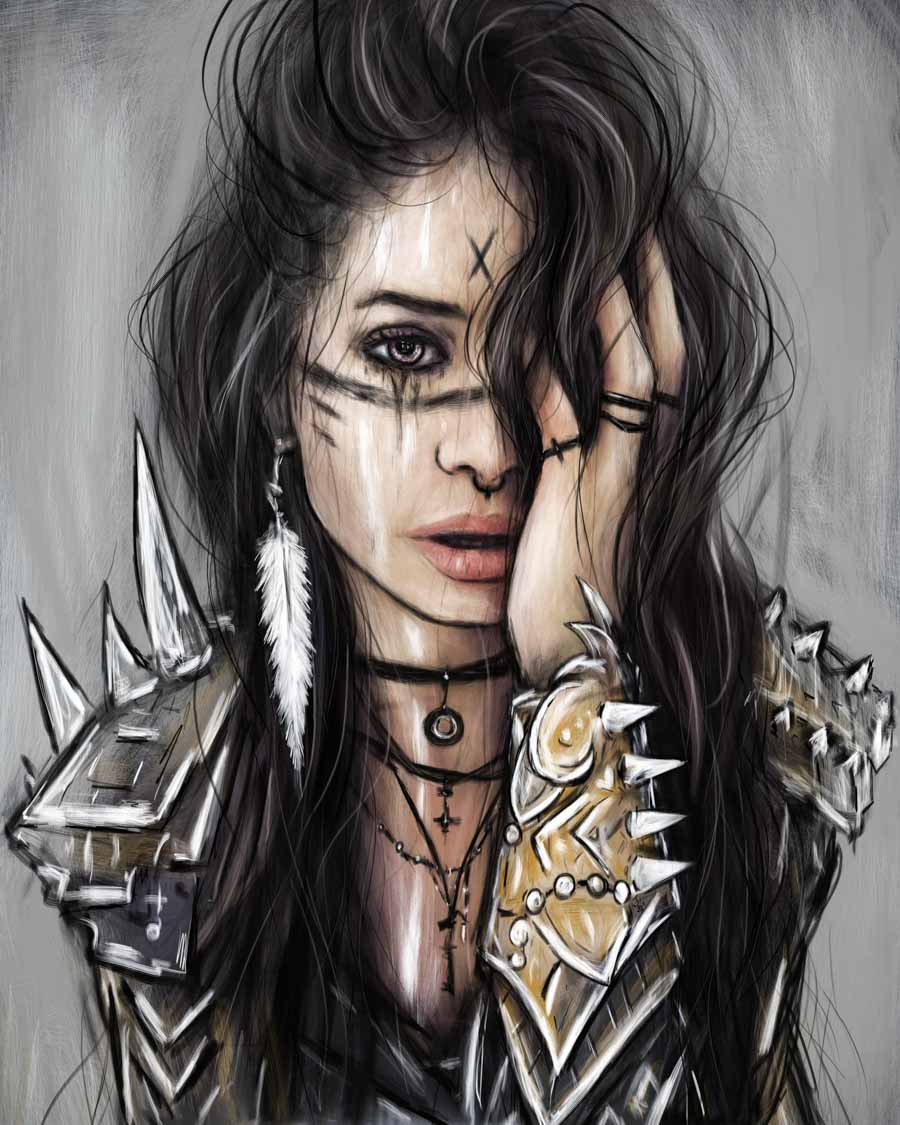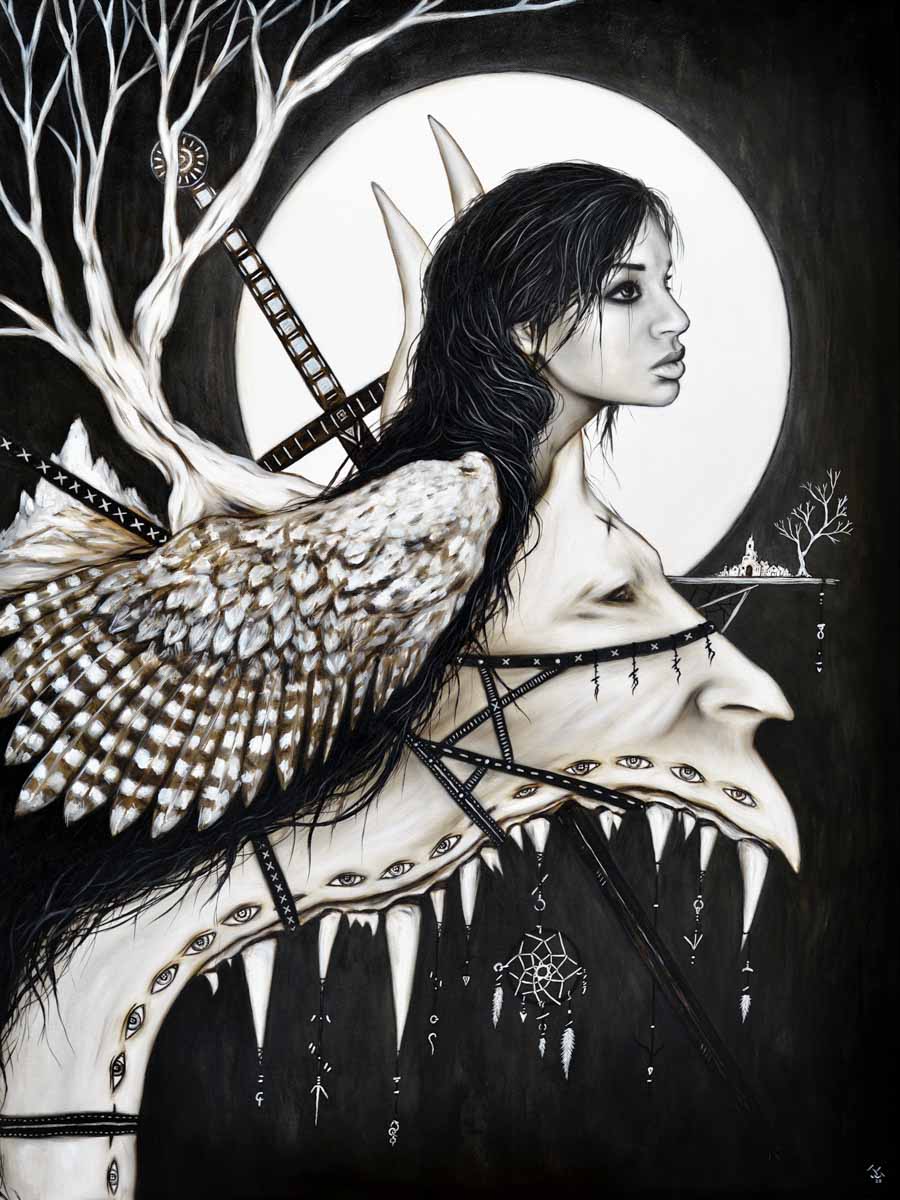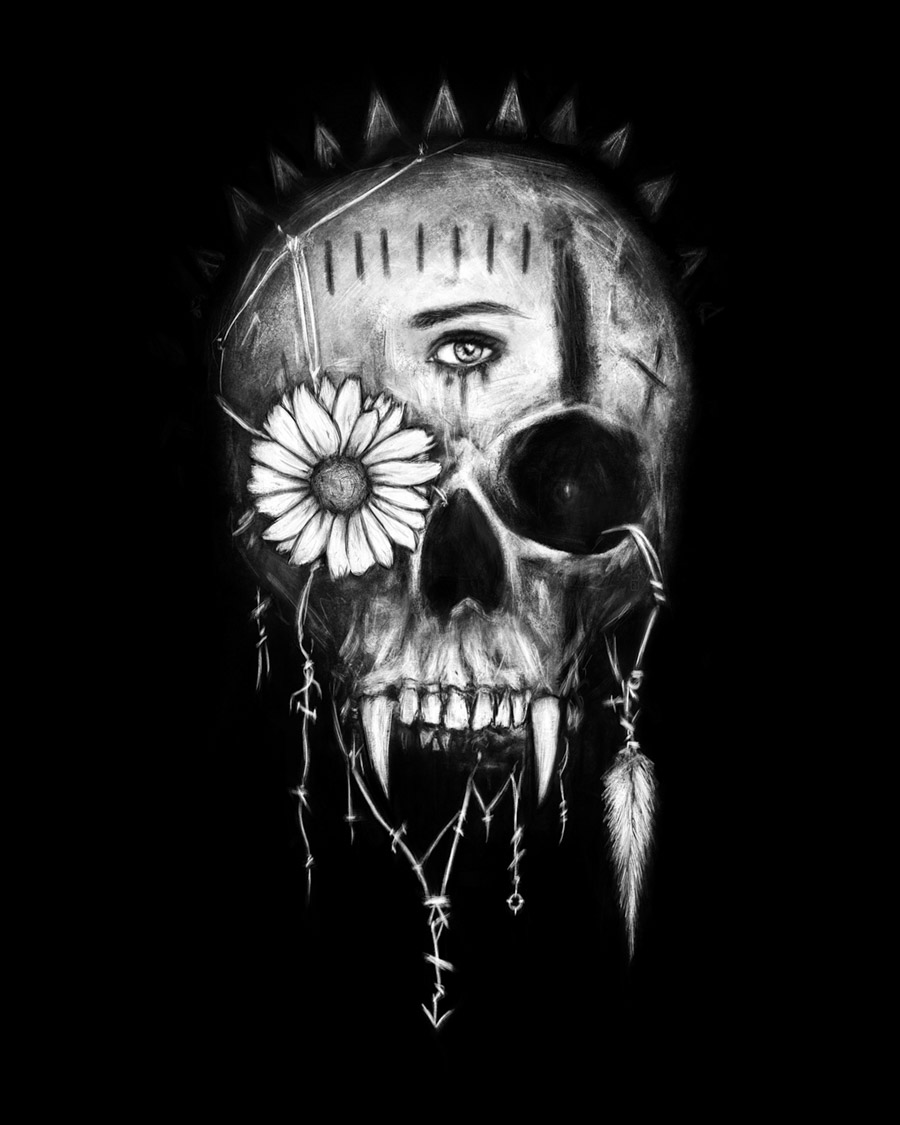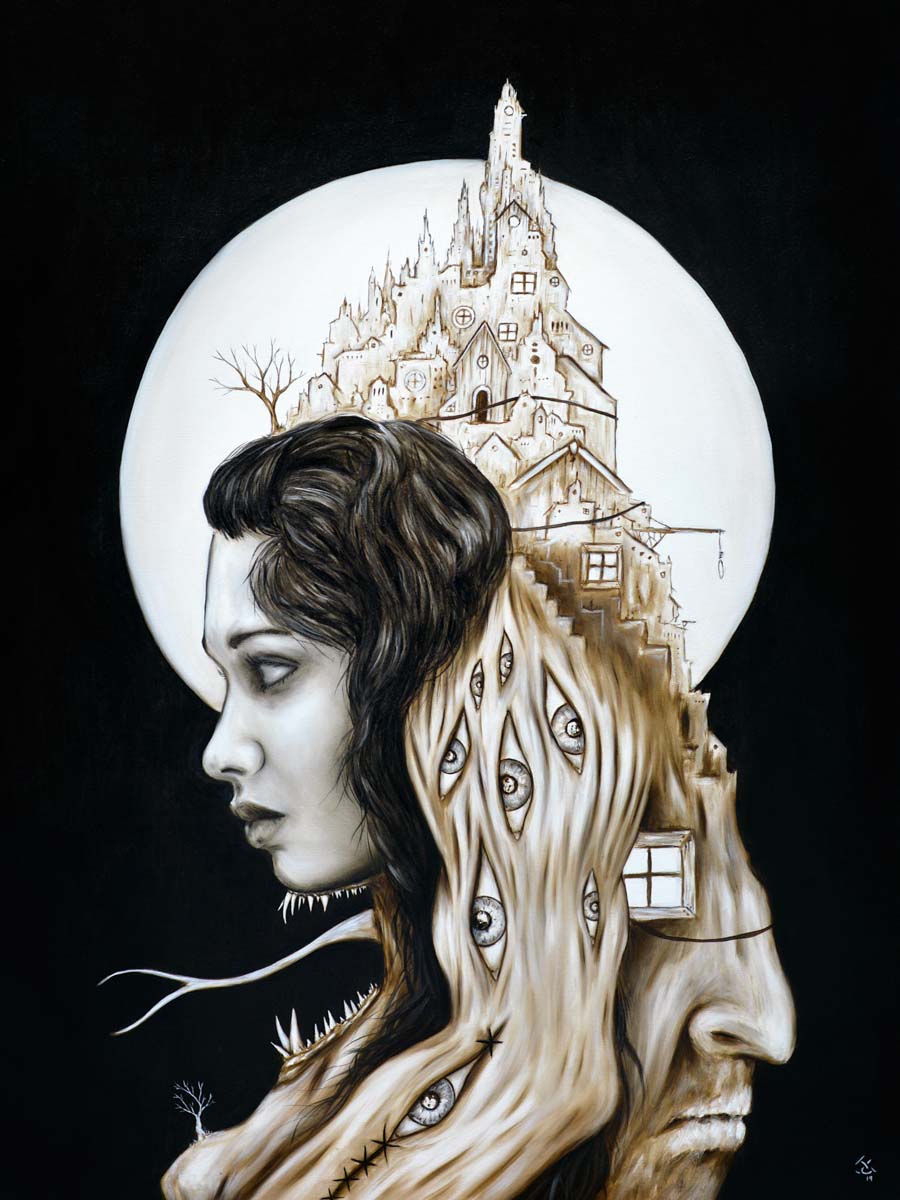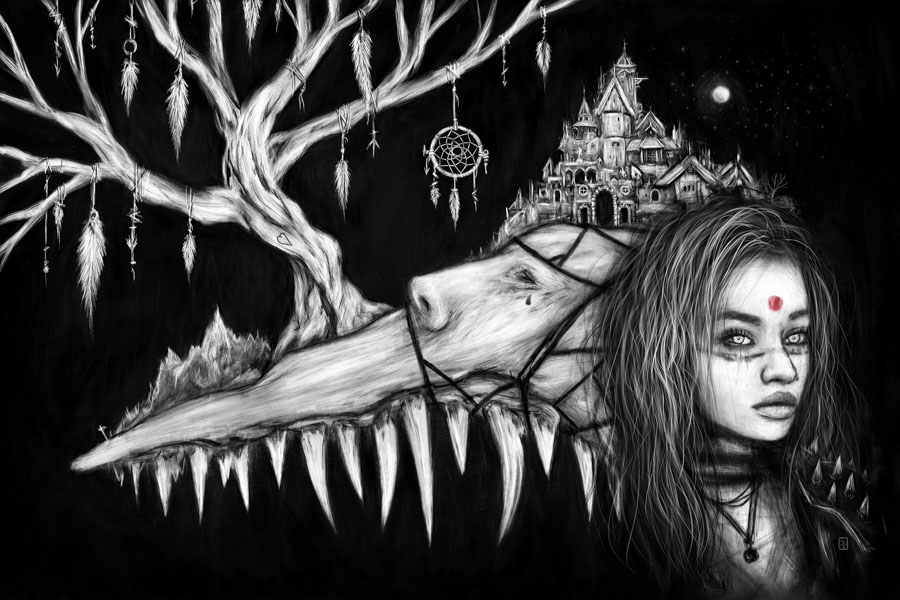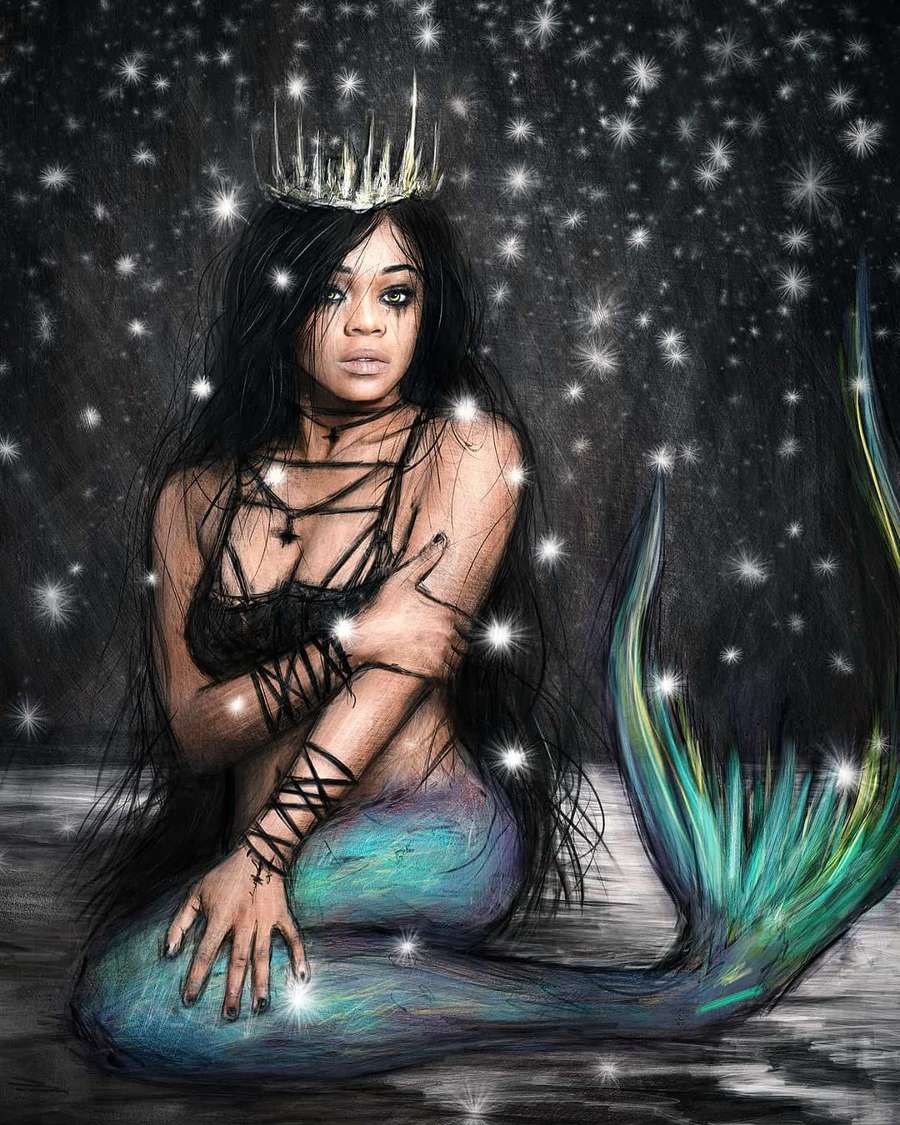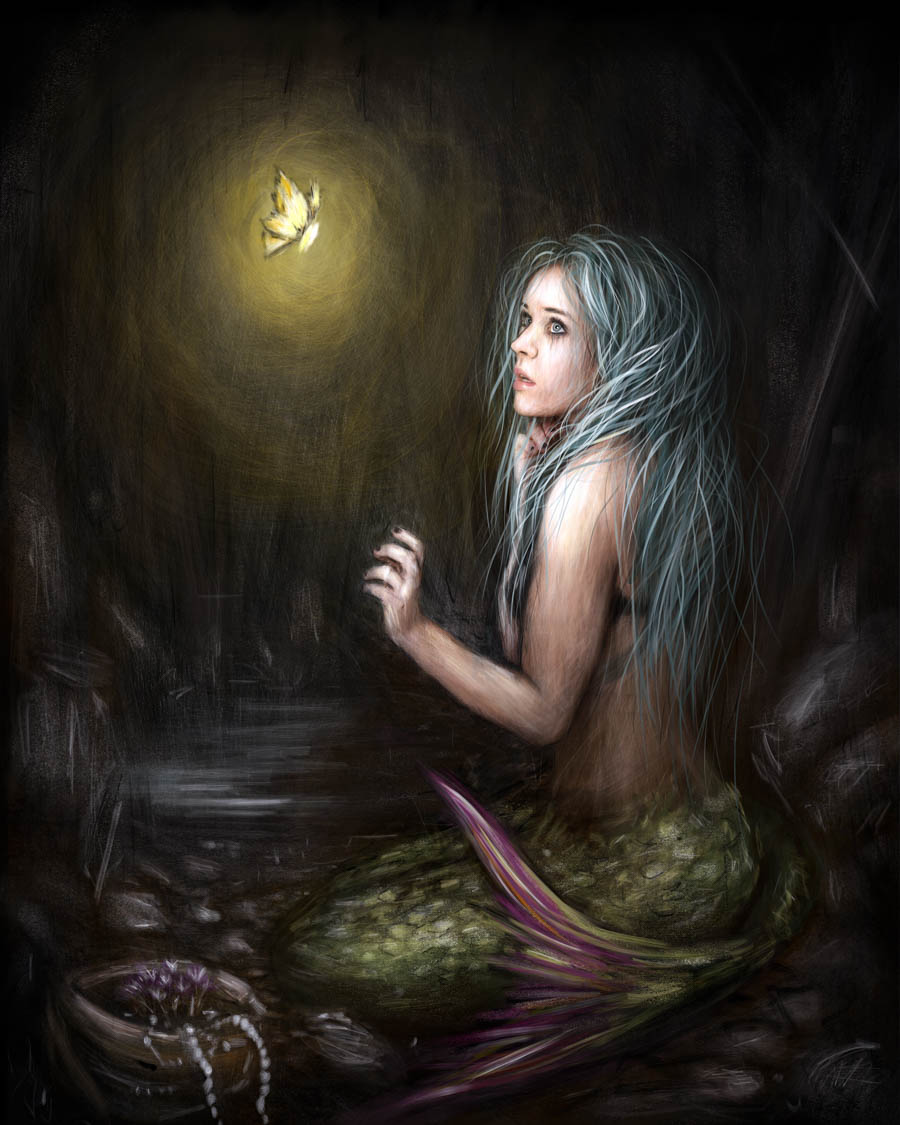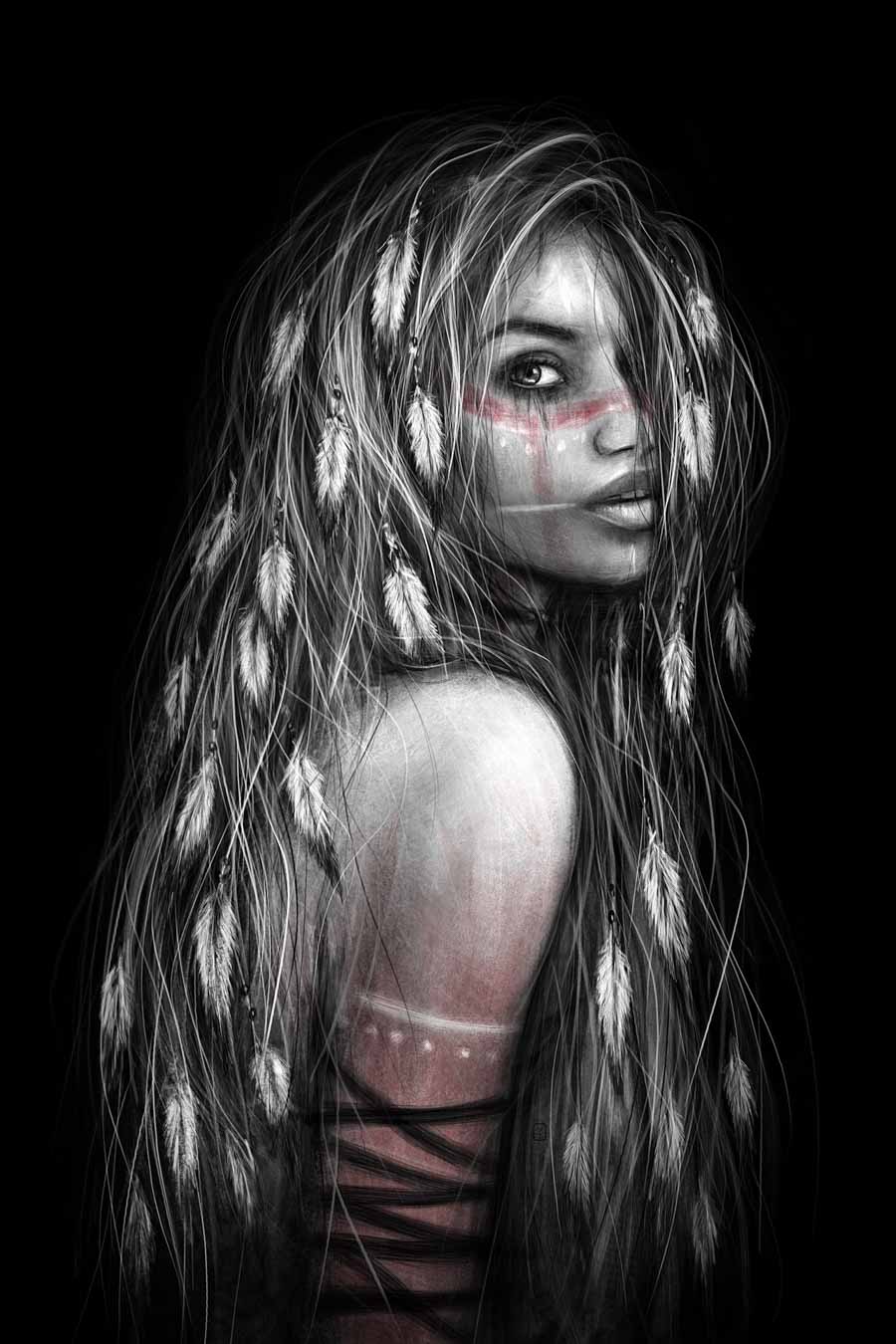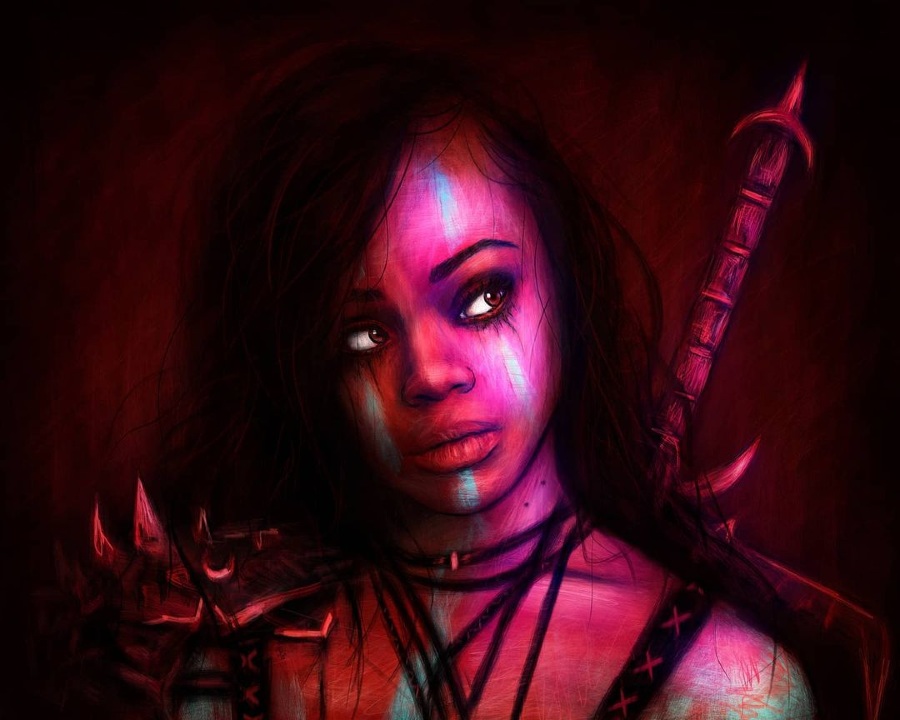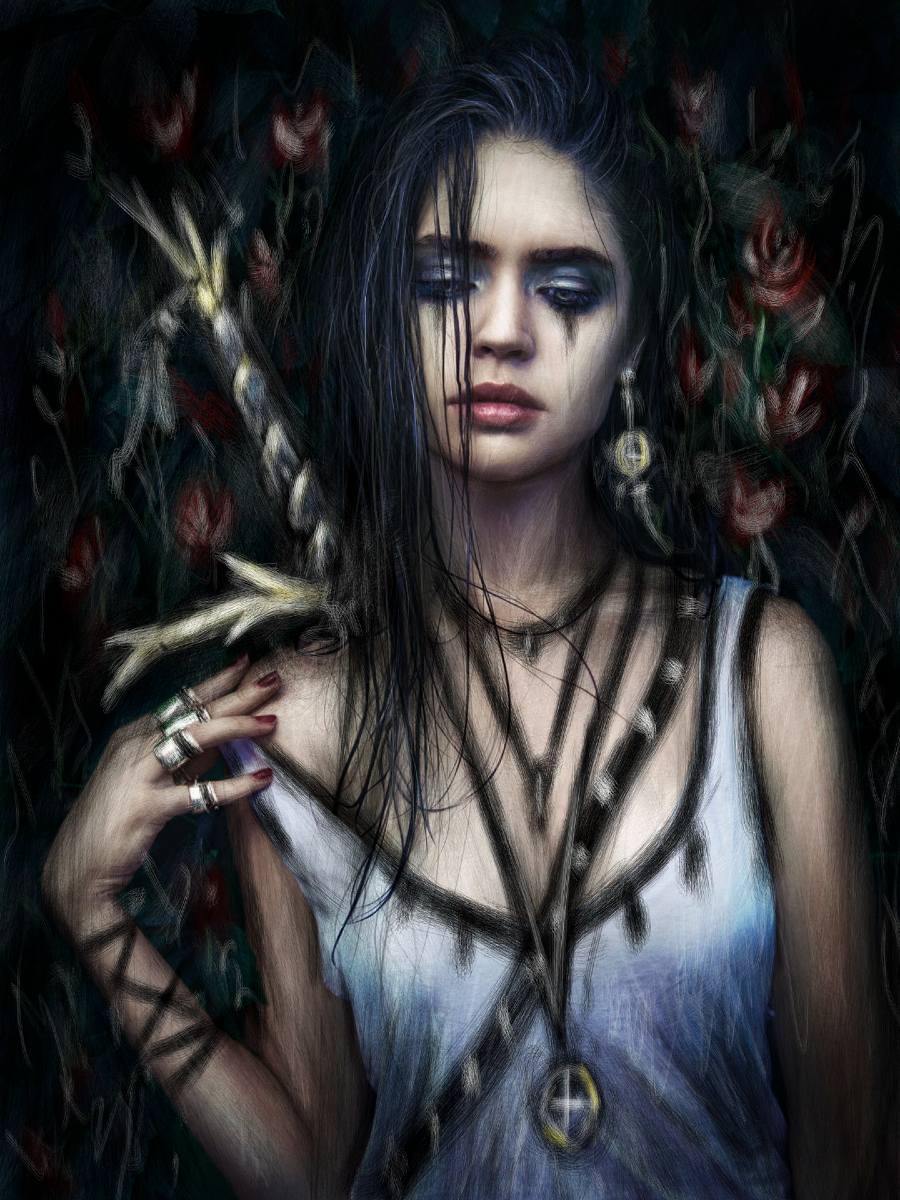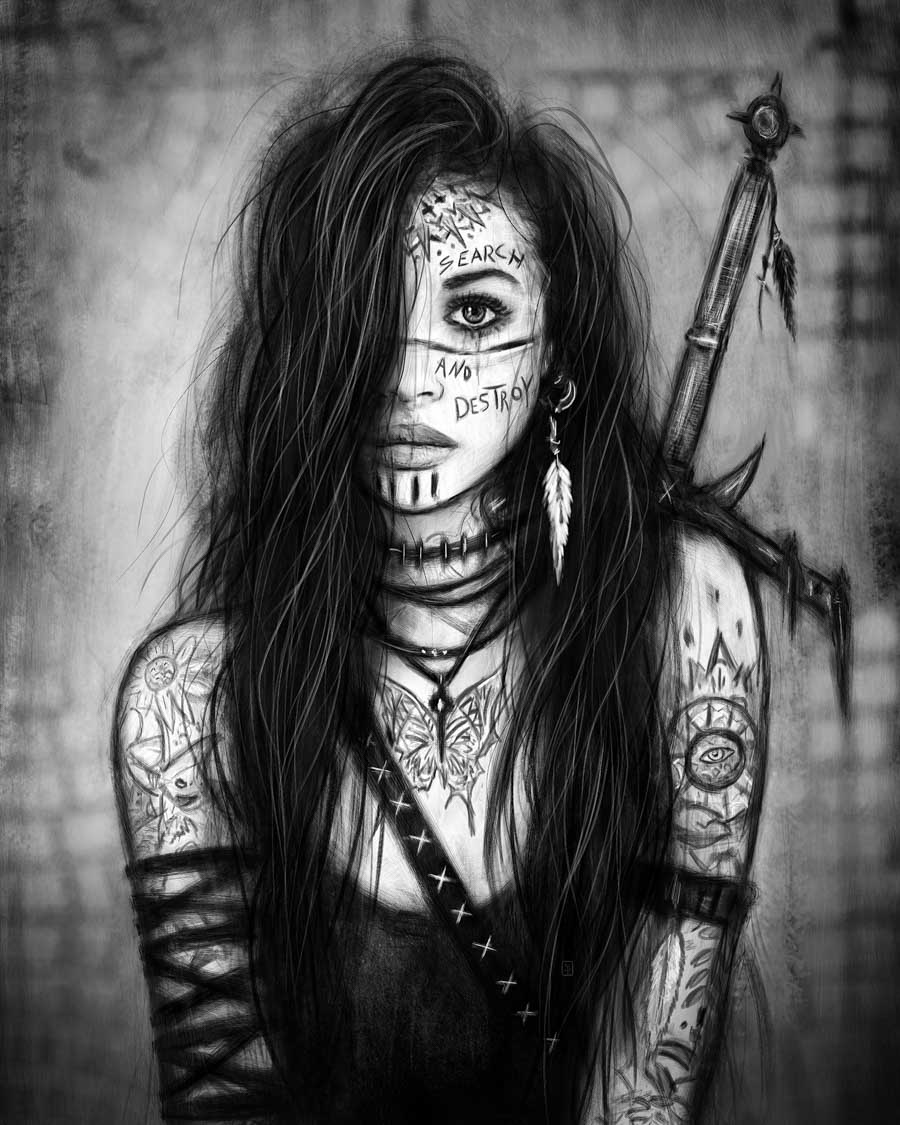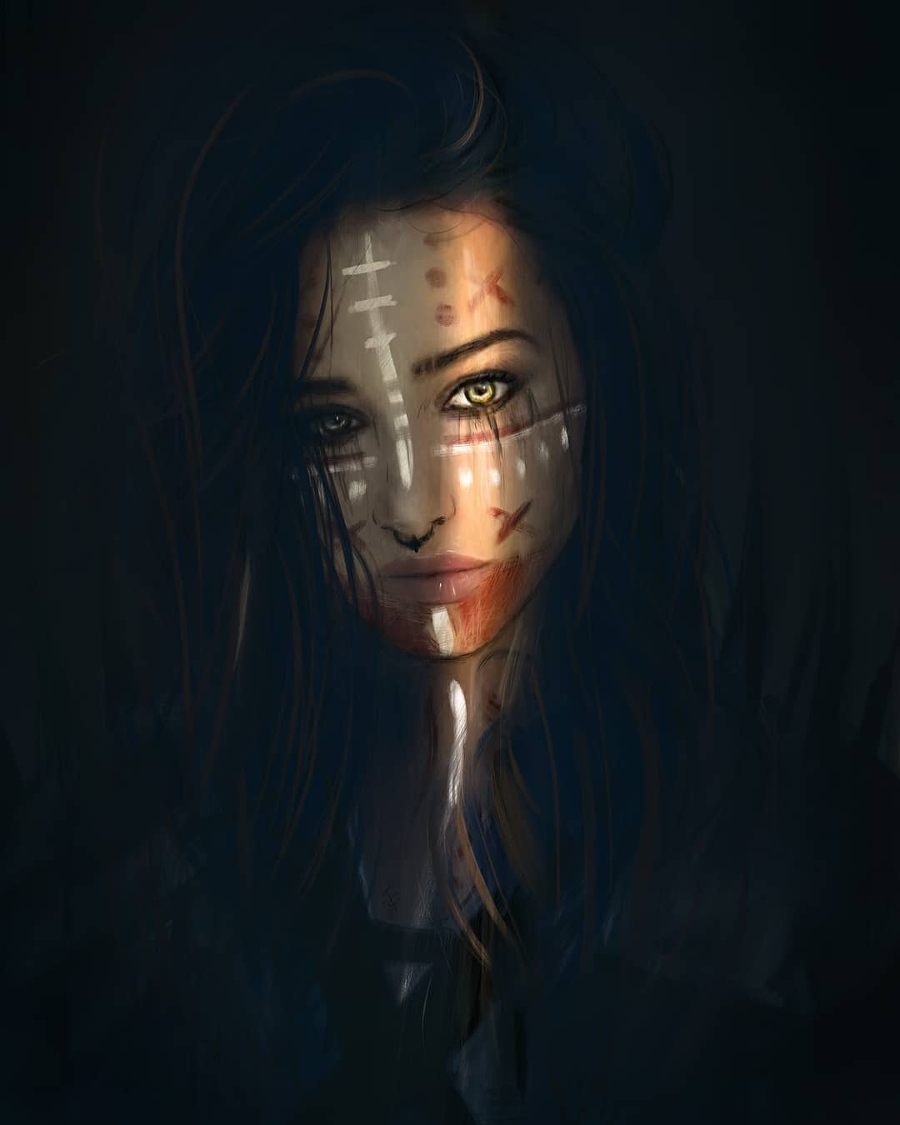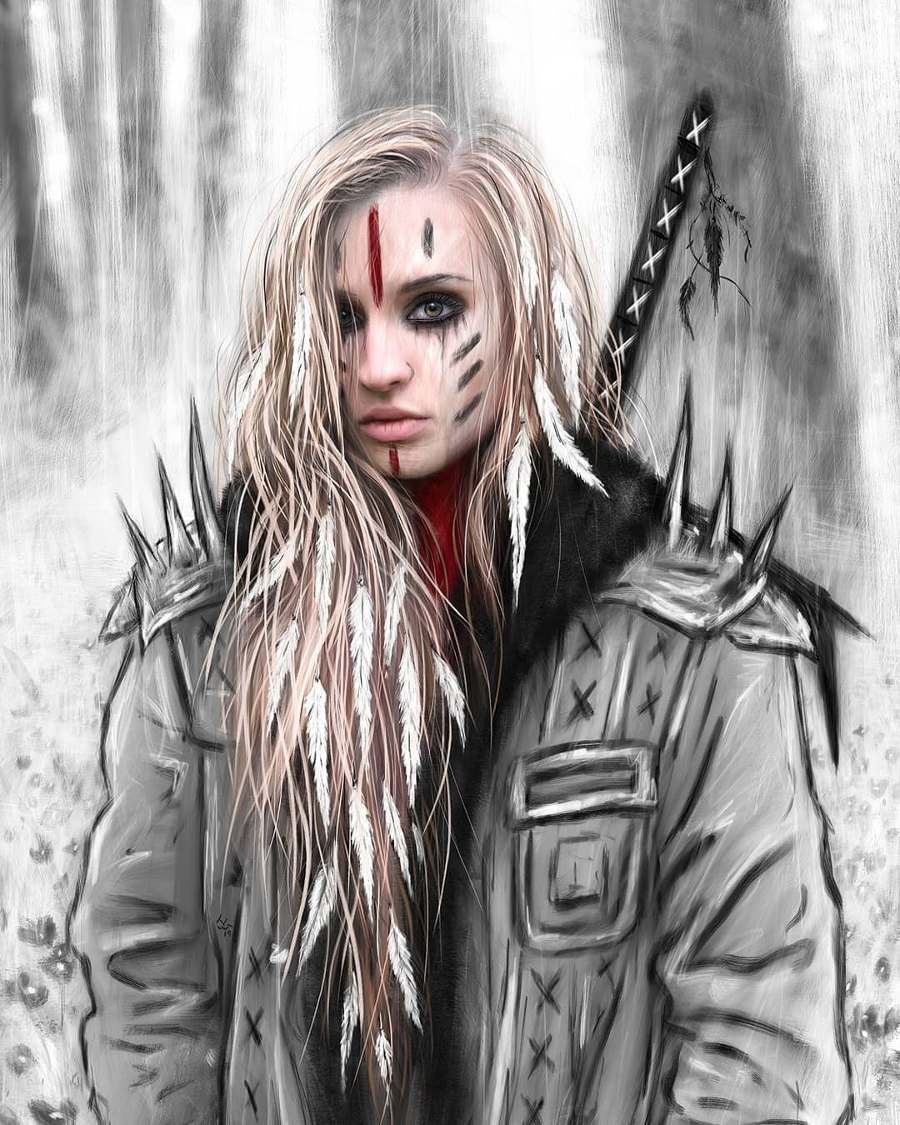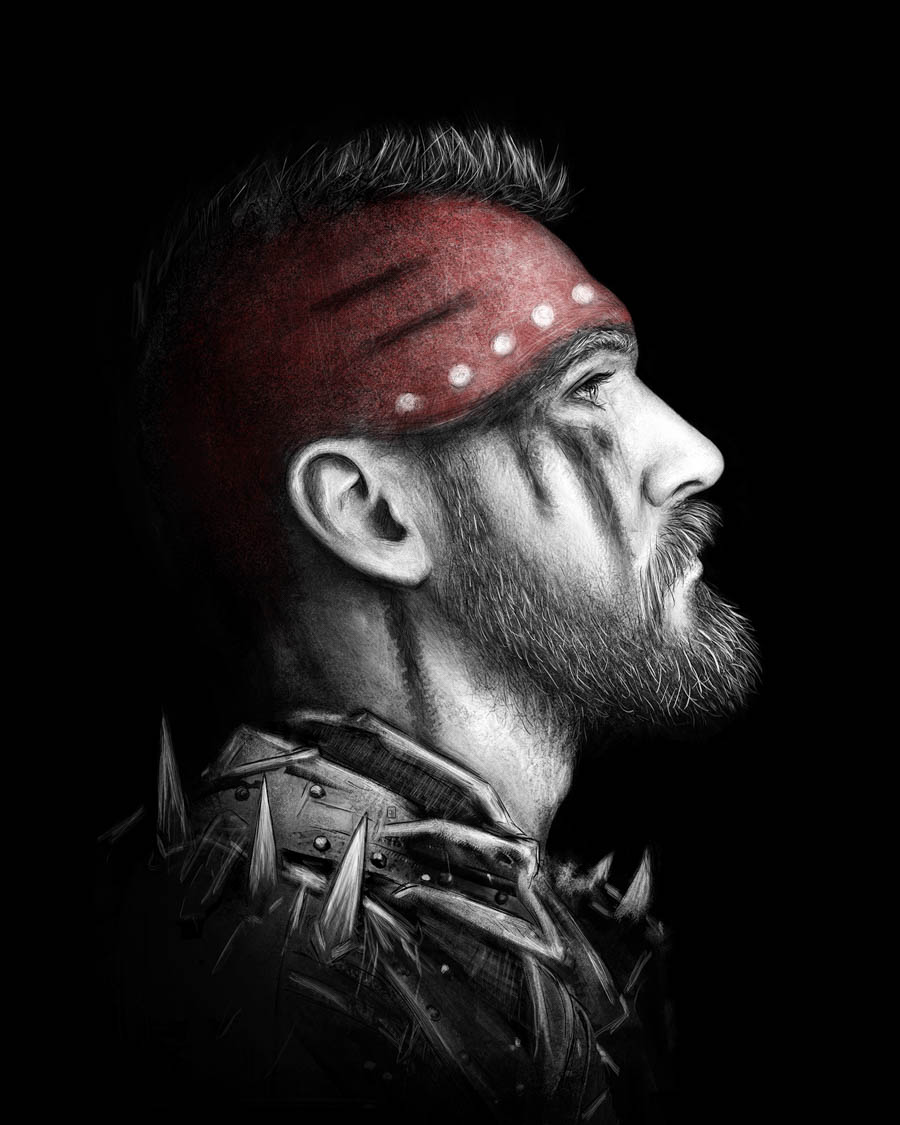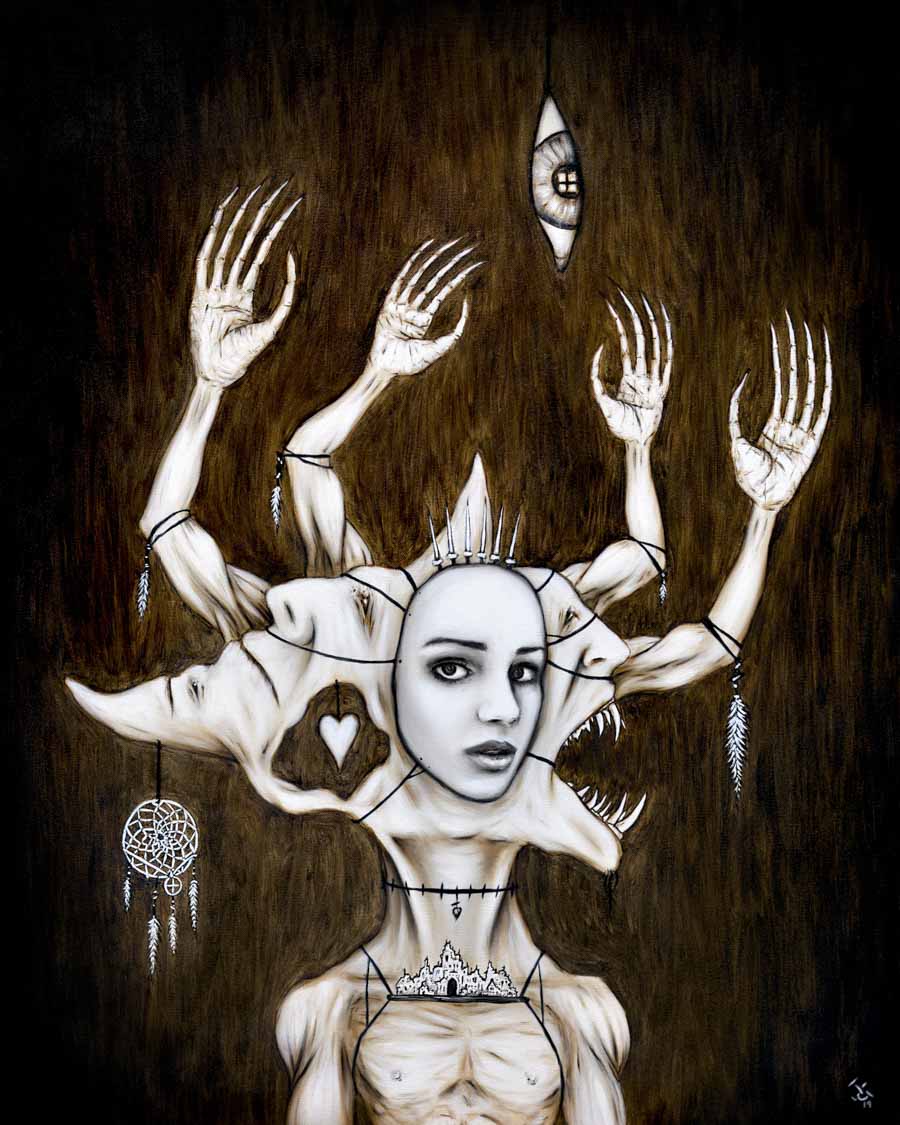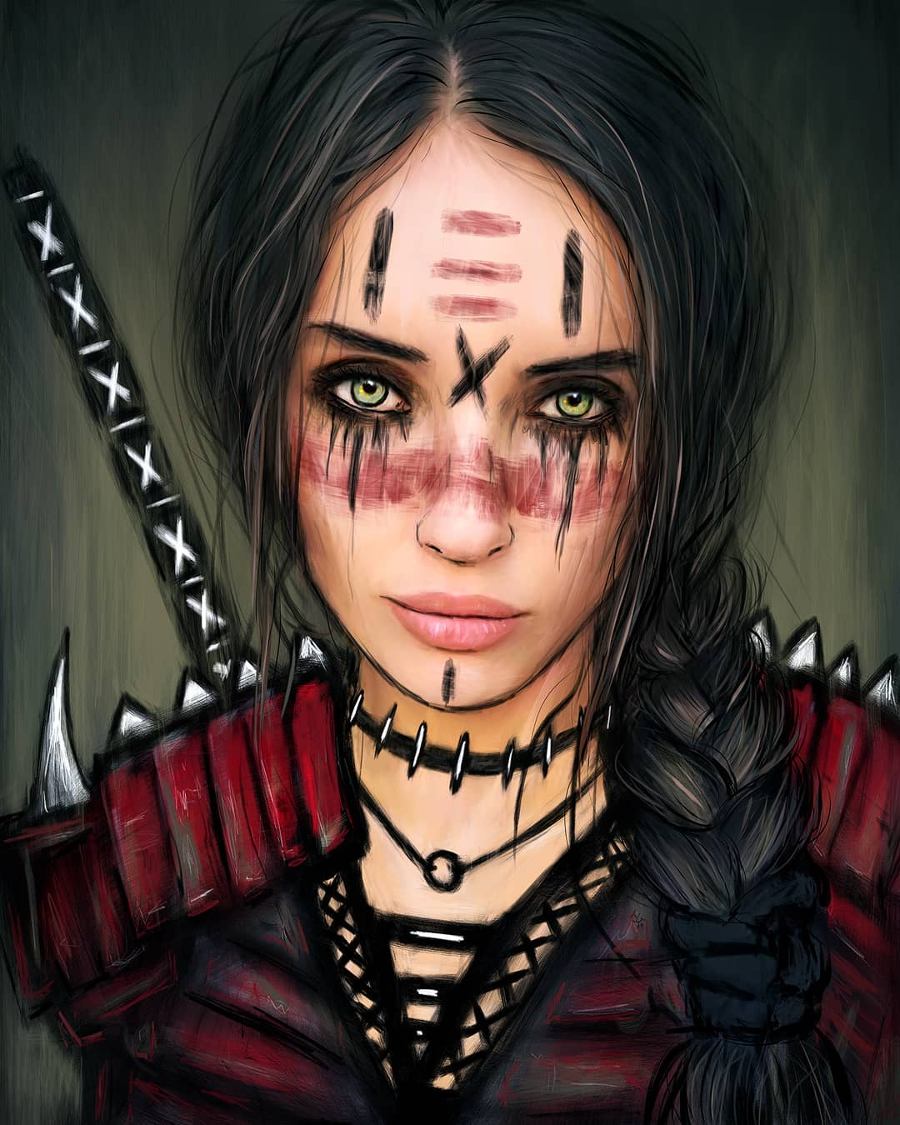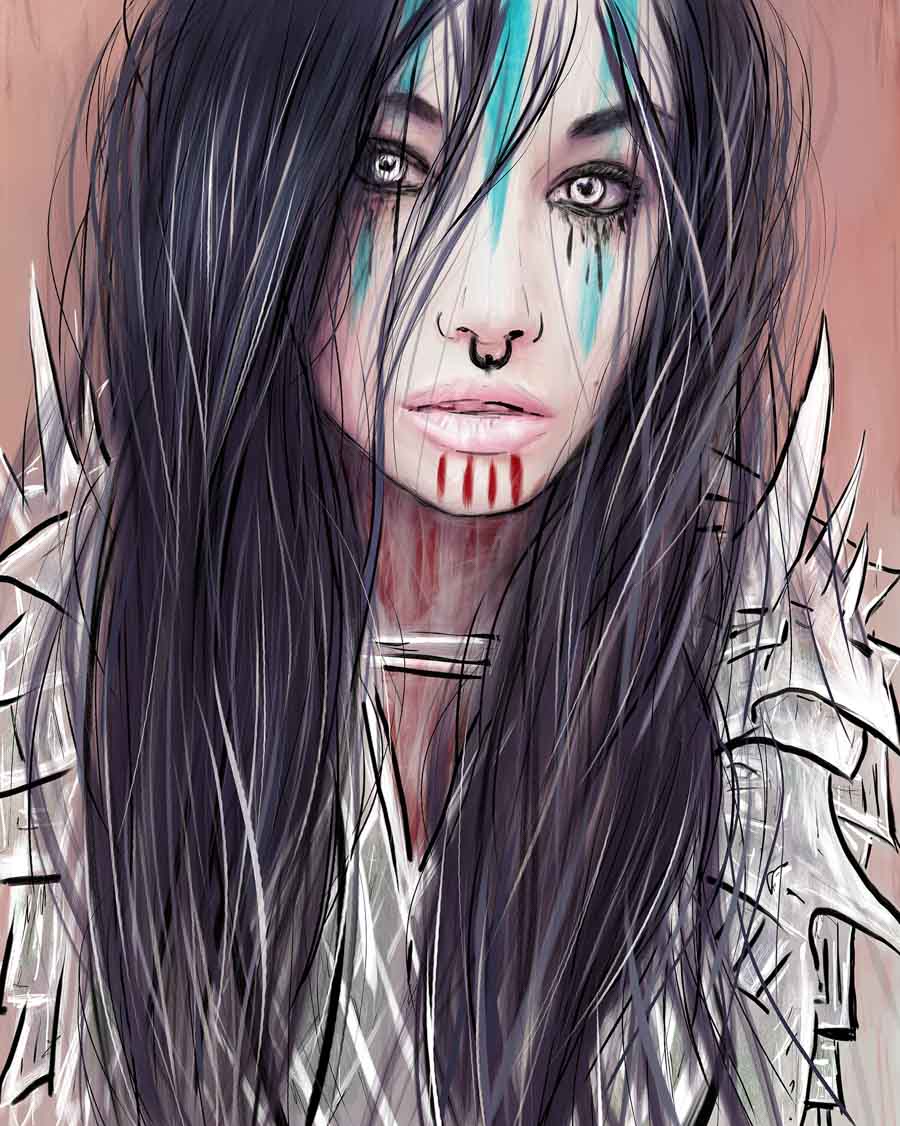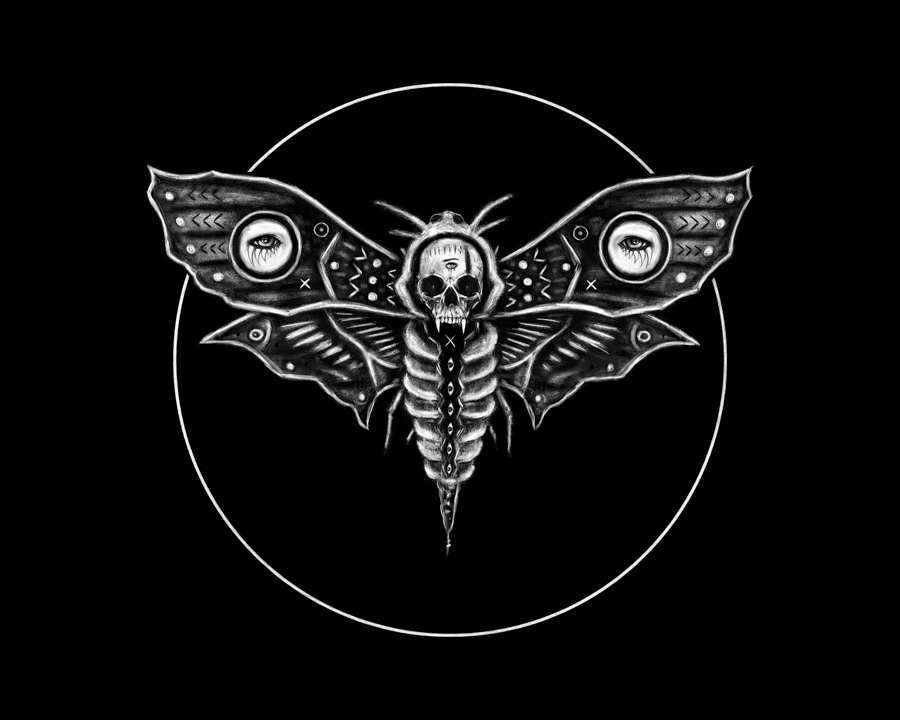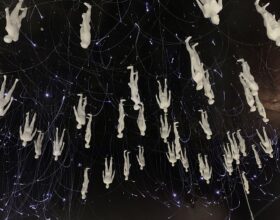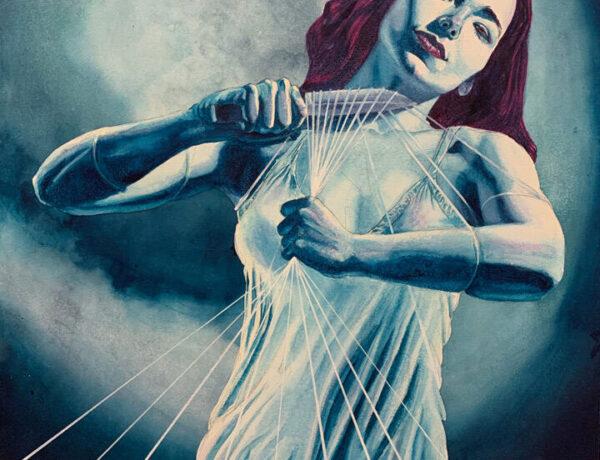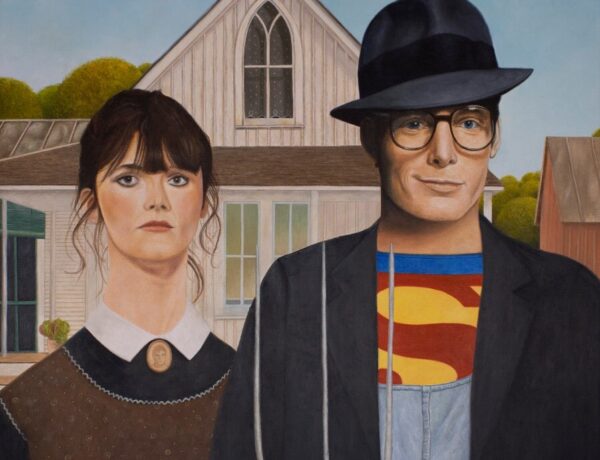In today’s pro-feminist culture, Justin Gedak’s tousle-haired, warpaint-streaked, weapon-toting, bad @ss babe battalion may be aesthetically on point, but the Canadian artist’s creative motivations have little to do with fulfilling societal trends or – the old standby – delivering superficial eye candy. That’s one of the unfortunate consequences of sizing up a work of art in the hot second that it takes us to speed scroll right past it. We miss out on the deeper, often relatable story that adds substantive layers to a creative individual’s work.
Justin Gedak’s digital portraiture speaks directly to those who have experienced unhealthy interpersonal relationships, or chronic anxiety/depression, or self-doubt, or a seemingly endless yet elusive quest for true purpose…the list goes on and on. If you find yourself wondering how you can possibly tap into an inner reservoir of strength so that you can successfully weather the turbulence in your life, look toward Justin’s gothic gladiators for a visual reminder of the warrior spirit that lives within all of us.
By painting the darkness, Justin Gedak casts illumination upon the many aspects of the human experience that tend to tarnish our spirits, sometimes enveloping us in a sense of despair. At the same time, his muses’ resolute demeanors offer us a beacon of hope. They clearly bear the scars of their battles and yet their direct gazes suggest that – one way or another – they are intent upon emerging victorious. What follows is a refreshingly honest conversation with an artist who paints with a light at the end of the tunnel perspective.
The illusion of needing to be ‘successful’ can be dangerous. It’s okay to make art without actually ‘making it’ as an artist.
Your exposure to oil painting began as a child with two parents who were self-taught. Did they pass along the majority of the techniques that you use today in your art practice or did you acquire your skills through an arts-based education?
I tried an art program at a local university but it really wasn’t for me, so – apart from learning basic oil painting techniques from my mother when I was around 10 years old – I’m mostly self-taught. I would have liked to learn more foundational art skills such as color theory, painting from life, etc. because I think it would have made me a better artist today. Still, I figured everything else out on my own through trial, error, and reading books. Regardless of nurture or nature though, art is something I’ve always been drawn to and keep returning to.
Is trying to figure out how to do everything yourself a big part of your personality?
I’ve actually spent a ton of time devouring different digital art tutorials and workshops, but I find that during my creation process, if I try to get too fancy using a bunch of different features, it takes me out of the creative zone.
While oils are a part of your creative pedigree and digital art is now your predominant medium, have you dabbled with other art making tools throughout the years that made a big impression on you?
I created oil paintings at a young age, and then I tried acrylics, watercolors, and various other mediums. There was a point when I saw a book of Albrecht Durer’s engravings – which amazed me – and I emulated his style with pen and ink, always trying to get better. I even shifted over to superhero drawings such as Wolverine, The Punisher, and Silver Surfer. By the time I hit 18 years old though, I started getting back into oil painting and creating darker surrealism-themed works.
There’s something about the old medieval and gothic aesthetic that I’ve always been drawn to, including the sadness which I actually find comforting.
At what point in your journey did it feel natural to call yourself an artist? Did anything in particular trigger that realization for you?
Even now, thinking of myself as an artist seems strange. It doesn’t hold me back, but I often feel as though at any moment I’m going to be exposed, and labeled as a fraud.
Digital painting is certainly convenient, economical, and flexible but you’ve admitted that it’s quite challenging to master. Did your oil painting roots positively impact your digital painting efforts or make it more challenging?
My many years of experimenting with drawing and painting helped my hand/eye coordination, plus it enabled me to maintain an open mind with regard to digital artwork. Teaching myself how to paint, digitally, was definitely challenging, though. Numerous times throughout my journey, I completely gave up on it. To this day, I’m still slowly learning new things along the way.
How experimental is your digital art process?
It’s almost as if my muses create themselves as they emerge from my subconscious mind. If I knew exactly what I wanted to do with a portrait before starting it, I’d probably get bored and have a harder time getting the energy to finish it. My creative process benefits when I’m able to maintain some of the mystery.
My approach to making art – creating what I want when I want – has helped me to enjoy the process a lot more, plus it’s given me more freedom to experiment and take chances.
Given your strong connection to oil painting, why do you continually reach for digital tools to express your creativity?
A digital painting typically takes a few days to a week, compared to oils which is more like a few weeks to a month – sometimes even longer. Not having to wait for paint layers to dry is aaaaaaamazing! Also, screwing up a digital painting – or realizing that it hasn’t manifested in exactly that way that you want it to – is far less devastating than when you work with oils. Experimenting with different ideas during the digital painting process can also be very liberating. I love being able to easily undo layers and/or go back to previous versions of a work of art.
When we chatted with you in 2019, you offered us a thorough explanation regarding how you bring a digital portrait to life. Would you shine light on the new technique that you’ve recently incorporated into your creative process?
Each new digital portrait I work on is inspired by a muse that I build out of bits and pieces of cut photos. “Sinner” is a really good example of this. I pieced together so many different photos of hands and arms – as well as a ton of different facial features – to create a muse that I wanted to paint.
I’m like a mad scientist, using a forehead from one photo, an eyebrow from another, a chin from another, and so on. Sometimes I’ll combine multiple photos per body part, and scratch different parts off. Initially, it looks really strange, but gives me an interesting base to work off of.
What is your favorite facial feature to work on and why?
Eyes are probably my favorite because they’re fun to paint. They also show and tell what’s really going on behind a person’s words or actions most honestly.
If you believe that the artwork you’re creating is important and it helps give you a sense of purpose, then everything else is kind of irrelevant.
Your dark gothic portraiture continues championing the innate strength of those who have prevailed through dark times. Why is that still such a compelling topic to you?
I stick with this theme because it feels important – almost as if it’s what I’m supposed to be doing. I view it as staying on the path, and working towards a sense of hope. Also, there’s something about the old medieval and gothic aesthetic that I’ve always been drawn to, including the sadness which I actually find comforting. What really clicks in my mind is the strange armor, exotic swords, and the vampiric-like mysteries behind their faces. By incorporating those details into my portraits, it’s a more purposeful way of telling a story about where my muses have been, what they’ve overcome, and what they’re about to undertake.
Do you expect to continue focusing mainly on gothic portraiture – with occasional thematic diversions like your ongoing surrealistic series – or are gearing up for a radical shift?
My surreal paintings are somewhat of a return to how I used to paint in my late teens and early 20s. My process begins with sketching really sloppy doodles on a blank piece of paper, which is a lot like digging around in white sand and pulling up dinosaur bones. I piece ancient things together, and then bring them to life through the painting process.
Gothic portraits will continue to be my main creative focus, though. In the future, I’d like to create works closer to the old Pre-Raphaelites like John William Waterhouse, and Sir Edward Burne-Jones.
While most of your portfolio features empowered fighters who rise above life’s challenges, it’s quite interesting to note that you’ve created nine portraits of mermaids! Spill the beans please!
I find it interesting that there isn’t a lot of good mermaid art out there. So, it’s kind of fun to shake up that genre by adding some of my own to the mix. Also, I have a daughter who really loves mermaids. She lives in another country, so I don’t really have the opportunity to be a part of her life, but I’m hoping that someday she might like to see my portraits.
It’s almost as if my muses create themselves as they emerge from my subconscious mind.
Despite favoring digital painting, from time to time you still paint traditionally with oils. What motivates you to select one medium over the other?
Mood has a lot to do with but there is a strange type of magic in oils that is hard to achieve with digital work. Experiencing an oil painting in person is soulful, and creating one is like haunting a canvas. A little more of a ghostly life is added with each painted layer.
Surely you’ve challenged yourself to haunt some pixels. Is there just one digital portrait in your portfolio that you believe comes close to capturing the soulful magic of oils?
I think that many of my digital portraits are haunting, but they’re not haunted. My digital portrait, “Feathers”, is possibly the closest that I’ve come so far. Oil paintings take it one step further, though. They just seem to have more of a presence to me, especially when they’re viewed in person. It’s like there’s something more alive inside of them.
The magic that surrounds the oil painting process and – of course – the final result is pretty significant to you. Would you please share a few examples of oil painters who sweep you away with their artistic alchemy? Is it their aesthetic, their execution, or just the vibration of their work that captures your heart?
John William Waterhouse’s paintings seem so full of life and they have such a magical sense of mystery. “The Lady of Shalott” is my all-time favorite painting by him. Another old-school painter who comes in a close second is Leonardo da Vinci.
It’s hard to choose just one contemporary painter. Casey Baugh, Jeremy Lipking, and Brad Kunkle are the first three absolutely amazing artists who come to mind. Brian Viveros, Troy Brooks, Yoshitaka Amano, and Luis Royo have also heavily inspired my work. Eve Ventrue’s digital paintings are also crazy amazing.
If I had to choose just one modern day painter who creates magic on a canvas, it would be Odd Nerdrum. His works are the most haunting, disturbing, and mesmerizing, and his technical skill is otherworldly.
Regardless of nurture or nature, art is something I’ve always been drawn to and keep returning to.
The fact that you seem to create artwork for the therapeutic benefit – and certainly the joy of the process (rather than specifically for profit) – gives you a bit of an indie artist vibe. Is that how you see yourself?
Yeah, I guess that probably makes sense. It’s kind of like I’m living in my own little artistic universe. My creative practice is also about needing to do something outside of myself, or something that seems worthwhile. If I was suddenly gone today, at least I would know that I did something meaningful with my life, instead of being forgotten by history.
By not caving into the pressure or expectations that tend to go hand-in-hand with creating art solely for profit, do you think that has enabled you to manifest art that is more soulful or authentic?
My approach to making art – creating what I want when I want – has helped me to enjoy the process a lot more, plus it’s given me more freedom to experiment and take chances. Also, if commissioned work doesn’t please a client, it’s nice to not worry about how I’m going to cover my bills.
While creating art hasn’t been a perfect solution for your anxiety and depression, it seems like it’s been a fairly decent antidote. Is the act of creating ever powerful enough to make you forget darkness?
Creating artwork does help me to preserve my sanity. It also helps with anxiety, depression, and pushing back the sense of dread that always seems to be lingering over me. I’ve always loved the concept of “the way out is through.” When I started my abstract series a few years ago, it was actually inspired by the idea of moving through obstacles and darkness towards a sense of hope and light. Painting actually makes me more aware of the darkness, but it also enables me to work through it and take more control.
Is there a specific part of the creative process that gives you an endorphin rush or pure happiness? The moment you stop painting, does the mental health benefit of creating art quickly fizzle out?
I experience a brief endorphin rush mostly when I first start a portrait, and when finally complete it. Generally, that feeling doesn’t linger, though. Sometimes I’ll also get a little rush when – after being stuck on something that looks or feels off – I finally achieve a breakthrough.
There is a strange type of magic in oils that is hard to achieve with digital work. Experiencing an oil painting in person is soulful, and creating one is like haunting a canvas. A little more of a ghostly life is added with each painted layer.
You’ve previously commented that “creating keeps me sane” and “without art, perhaps I might be a bit more lost”. Maybe that’s why you’ve been so prolific? Could it be that painting is your constructive addiction?
I’d say this is very true! Art keeps me on the path (to partially paraphrase Jocko Willink). I’m not a very social person, plus I don’t drink alcohol anymore, so those things contribute to my creative productivity, as well.
So many creatives – even those who are not depressed – wrestle with thinking that they aren’t good enough. Interestingly, you have more of a glass half full perspective – you never give up and are quite self-propelled to continually refine your skills. What would you say to all of the artists who are hanging on by a thread, drowning in self-doubt?
To be honest, I’ve had plenty of days when I thought I wouldn’t be able to make it through, but somehow I did. My advice to others is to keep creating, and to give deeper thought to why you’re creating. The illusion of needing to be ‘successful’ can be dangerous. It’s okay to make art without actually ‘making it’ as an artist.
I think that if a person focuses too much on needing to be an artist rather than creating artwork, it’s easier to fall into a dark and hopeless place. If you believe that the artwork you’re creating is important and it helps give you a sense of purpose, then everything else is kind of irrelevant.
Justin Gedak Social Media Accounts
Website | Instagram | Facebook | Twitter | Tumblr | Pinterest


